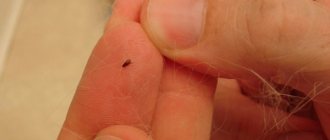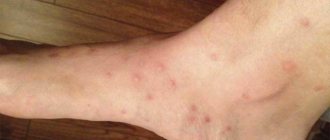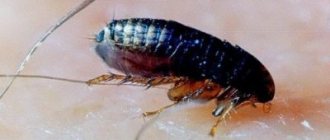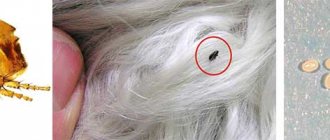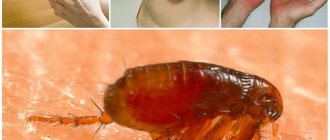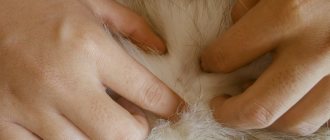Fleas can appear in cats even if the cat lives indoors and does not have access to the street. Fleas are found everywhere; they are an order of insects that includes subspecies that feed on the blood of domestic animals and even humans. The larvae of the parasite on shoes can be brought into the house by a person; an adult insect can enter the house through cracks.
The presence of fleas in a cat may be indicated by changes in the pet's behavior. The cat begins to scratch itself and has trouble sleeping. Fleas are dangerous not only for cats, but also for humans. Parasites are able to live outside the animal and actively feed on human blood if there are no other sources of food.
Effective drugs and methods are offered to treat an infected pet. Some of them can remove fleas instantly, others act gradually. There are products that need to be reapplied. When choosing, the cat’s age, health status, lifestyle and the feasibility of carrying out a specific type of treatment are taken into account.
Causes
A pet can become infected in various ways. Fleas easily adapt to a new habitat; parasite larvae are resistant to unfavorable conditions, are able to exist outside the host, and do not require nutrition at an early age.
A cat can become infected:
- On the street, while walking . Contact with an infected animal is not necessary. Adult fleas and larvae are present on benches, grass, and sand.
- Through the owner. Fleas can attach themselves to clothing, shoes, or your hand (if you pet a cat) and enter the house where the pet lives. You need to be careful when visiting. In a house where a cat lives, larvae and adults can be found not only on the animal, but also on furniture, other objects, and bedding.
- From mother at birth . If a cat has a similar problem, the likelihood that she will infect her litter is very high. That is why veterinarians advise treating an adult animal before lambing, thus preventing infection of kittens.
- During the hunt . Rodents are carriers of both various infectious diseases and fleas. By hunting them, the cat can become infected.
Features of cat fleas
The flea that can be found on a cat is the closest relative of rat and dog fleas. But despite this, its appearance is quite specific. Although the subtle differences between flea species are only accessible to specialists, it is useful to know the appearance of cat fleas. These parasites can transmit many dangerous diseases by biting a person.
It is mainly this type of flea that attacks cats, other animals and people in both rural and urban areas. While other types of fleas “remain faithful” to one “master”. Interestingly, if cat fleas settle on a rat, they will soon completely displace these same insects, which parasitize only on rodents.
There are no anesthetic enzymes in the saliva of a cat flea, so its bite is very painful.
What do pests look like?
The flea that parasitizes cats looks like an extremely small insect of a dark brown, almost black color. She can literally appear for a second in the animal’s fur and hide there again. The size of the parasite's body directly depends on its age and can range from 0.8 to 4 mm, the average length is 2–3 mm.
This type of insect is devoid of wings, but its powerful hind legs more than compensate for their absence - they allow it to disappear from sight with lightning speed, jumping to a height of 30 cm in any direction. The body of the parasite is flattened on the sides, which gives it the following advantages:
- It's hard to crush a flea
- it is convenient for her to move in her owner’s fur,
- During the jump, air resistance is almost not noticeable.
Video: cat flea under a microscope
It is worth noting that cat fleas and lice belonging to different types of insects can annoy cats. Moreover, it is almost impossible to meet them on one representative of the cat family. The louse lives in the fur constantly, but the flea only jumps on your furry pet while feeding. And lice cannot change their source of food, while a flea does this easily and with pleasure.
The dimensions of a cat flea are smaller than those of a rat or dog flea. In addition, in a rat parasite, the end of the body is slightly raised, while in a dog parasite, the head is larger. True, it is very difficult to notice all these differences by eye, because the parasites sit in one place only during the bite, and their small size interferes with a thorough study of the flea.
Photo gallery: different types of fleas
The cat flea parasitizes not only “its” animal, but also other mammals
The human flea most often lives near where a person sleeps
Rat fleas are carriers of many deadly infections
The dog flea's body is covered with bristles, and its legs have hooks that help it stay on the dog while moving.
How to tell if your cat has fleas
At the very beginning of the appearance of fleas, they may be invisible to the eye, but already at this time signs appear that should alert the owner. So, the cat begins to twitch sharply and immediately itch, while literally biting into the fur and skin. Under the fur you can see scratches from scratching. The following experiment will help identify the presence of parasites:
- The cat is placed on a white sheet of paper.
- They begin to comb the animal.
- If small black-brown pellets appear on the white surface, this is flea excrement. To further check, drop water on them - they will take on a brownish-red hue.
Observing them live will help you to finally make sure that your pet has parasites. To do this, move the cat's fur with a fine comb in several places and you will be able to see the moving flea or its feces, which look like black dust or sand.
The cat flea development cycle involves eggs, larvae and pupae being laid and developing outside the animal's fur, so only adult fleas bother the cat
During the process of breeding, female parasites do not lay eggs, but literally shoot them as far as possible in different directions. This gives more larvae a chance of survival if conditions are unfavorable.
How to recognize the presence of parasites in an animal?
The presence of fleas in a cat is accompanied by changes in the pet's behavior. The cat becomes restless, begins to scratch itself, and sleeps poorly. In severe cases, the cat loses its appetite; if the infection is severe, the cat may scratch the bite site until blood appears.
You can also recognize the presence of fleas in a pet if you have an idea of what the insect looks like. Fleas are blood-sucking insects of brown color, the size of which varies between 2-4 mm. They are active, agile and jumping. Adults feed exclusively on blood and can remain on the body of their owner for a long time.
The larvae resemble white, fleshy caterpillars and feed on organic waste. The larvae cannot be detected on the body, since they live in secluded corners of the apartment. Fleas do not live on the body of their prey all the time; they accumulate closer to the animal’s habitat. Cats are predominantly parasitized by cat fleas. However, if we take into account the ability of parasites to migrate from one type of animal to another and their unpretentiousness in terms of blood composition, rat, bird, and dog fleas can also be found on a cat’s body. Only a specialist can recognize fleas by their species.
Ways of occurrence of fleas and symptoms
Fleas in cats are parasites that are most often found in the summer in animals that go outside. Their appearance in the fur requires an immediate reaction from the owner aimed at destruction. Such parasites are carriers of various diseases and pose a threat not only to cats, but also dangerous to humans, because they can also bite people.
If insects multiply heavily in your pet's fur, diseases such as anemia, weakened general immunity, and others are possible. As a result, every owner should know what fleas look like on cats, where they come from and the signs of parasites in a pet, and then think about how to get rid of them.
Ways of parasites appearing in domestic animals:
- accidental introduction of flea eggs or larvae from the street or from the entrance; according to statistics, 95% of these insects live in the basements of apartment buildings;
- from a neighboring apartment where there are infected pets;
- after contact with yard or wild dogs and cats.
Signs of the presence of fleas
In modern cities, there are a large number of homeless animals, and the presence of unsanitary conditions contributes to the reproduction and comfortable existence of various types of parasites that migrate and infect pets.
On a note!
Fleas often carry worm eggs, so after eliminating ectoparasites from a pet, it should be additionally treated with anthelmintic drugs.
Symptoms indicating the presence of fleas in a cat:
- the animal behaves restlessly, actively itches, tries to bite off parasites and licks itself;
- some cats become nervous due to constant itching;
- Living adult insects can be found among the undercoat;
- red dots appear on the skin at the sites of bites; if an infection occurs, they become inflamed and can develop into wounds, possibly causing dematitis;
- black dots are visible among the fur - flea excrement;
- Pests can be found in places where a cat cannot reach them: near the ears, in the armpits, on the back, chest and neck.
If you suspect that cats have fleas, you should carefully examine the fur for the presence of black spots of digested blood. Flea feces, when rubbed with your fingers, are separated into small particles that are clearly visible among the hairs. If the undercoat is short, the animal combs it onto the floor, where it can become food for the larvae.
How to check a cat for fleas?
A visual inspection of the fur and skin will help determine if your cat has fleas. You need to take a comb and carefully push apart your pet's fur. The presence of black specks of excrement on bare skin indicates the presence of fleas. You can determine that the black lumps found are parasite feces if you place them in a container of water. The flea excrement will dissolve in the water and at this point the liquid will turn red.
In cases of severe infestation, flea eggs may be found in the pet's fur. The eggs are smaller than a grain of rice. The embryos are white or yellowish in color, and the membrane is devoid of stickiness. Parasites usually reproduce outside the body of their host. The female lays eggs while moving, causing them to scatter.
Embryos even roll off wool and hair, since they have a smooth shell. Therefore, from time to time you need to inspect and check the area adjacent to the cat’s habitat in the apartment.
You can tell if a cat is infected by the presence of wounds, red swellings, and blisters on the skin. By examining the damaged areas of the skin through a magnifying glass, you can determine that these are flea bites and not a rash. The bites appear as small red spots with a characteristic puncture point in the middle. When a cat develops an allergy to flea bites, the affected areas become swollen.
Flea reproduction
A female flea can lay up to 10 eggs per day, which she shoots in her fur onto the skin without attaching them to anything. They are very small, about 0.5 mm, white, visually similar to semolina groats. You can see what flea eggs look like in cats in the photo below.
Reproduction of fleas and their eggs
The eggs easily slide off the fur, onto the floor or into the grass outside when walking. The flea larvae in cats that hatch after 14 days look like small dark worms that lack legs and eyes. The size of the larvae can reach 6 mm with a thickness of about 1 mm. They feed on organic waste or blood particles from flea feces.
Habitats for flea larvae: dust on the floor, carpets and furniture, various fleecy fabrics, ceiling cracks. Therefore, regular cleaning of the house with a vacuum cleaner will help greatly reduce the number of larvae and fleas in the apartment.
First symptoms of infection
Only an attentive owner can notice the first symptoms of infection. The pet begins to itch intensely. Fleas try to stay in places that are difficult for a cat to reach: on the back, near the ears, in the armpit, on the skin in the chest and neck area of the body.
A visual inspection reveals traces of flea activity in the form of small black dots. White flea eggs are found in the pet's sleeping area. Cats often develop an allergic reaction to flea bites, which is explained by the presence of a toxic substance in the insect's saliva.
The first symptoms are a fairly serious reason to start treating your pet, since a neglected condition is fraught with serious consequences, since parasites multiply very quickly.
Second stage
Since insects reproduce quite quickly, the disease can progress to the second stage in a short period of time. This phase of the disease is revealed by the cat’s expressed anxiety. The pet is nervous, constantly meows, bites itself, trying to destroy the parasites. The furry animal loses its appetite, refuses its favorite foods, and sleeps poorly.
At the second stage, the number of fleas reaches 200 pieces. By parting the fur, you can easily see the parasites. The animal's body is covered with bites, scratches, and bleeding wounds.
Progressive disease
Without treatment and the necessary care, the disease progresses, turning a cheerful, playful cat into a nervous and irritated creature.
The cat begins to lose weight sharply, as it practically does not eat. The condition of the coat changes. It falls out in shreds, and bald spots appear in some places. Cats are sensitive to allergens, and insect saliva contains a toxic substance that causes allergies in most pets. As a result of flea bites, an animal may develop allergic dermatitis. The condition is extremely dangerous and the pet must be saved immediately. The presence of a large number of fleas can lead to the death of a cat.
Flea infestation is especially dangerous for small kittens, who begin to rapidly lose weight. Most kittens develop anemia; in advanced cases, the cat may die.
How can you tell if a cat has fleas?
These parasites are capable of multiplying at lightning speed. Therefore, their presence can be determined by the following manifestations:
- Severe, frequent itching. The pet is constantly itching and acting restless. The larger the colony, the more severe the itching.
- Deterioration of coat condition. It becomes dimmer. Bald patches may appear as a result of hair loss.
- Small wounds and scratches can be found on the body. When infection attaches to the wound surface, abscesses and fistulas may develop.
- When there is a large accumulation, they are clearly visible on the pet’s face and neck.
You can also determine their presence if you stand the cat on a white sheet of paper while brushing. Small black dots will be visible on the paper sheet. This is flea dirt or their feces. To be sure, pour a little water on them and they will turn red or brown.
Sometimes you can see small whitish dots, these are flea eggs.
Flea
How do fleas reproduce in cats?
On average, the life cycle of a cat flea lasts 10 days. During this time, an insect ready for reproduction grows from the egg. The population composition changes within 2-4 weeks. Under unfavorable circumstances, the duration of the cycle can last up to 2 years.
In 1-2 months, an adult manages to make 70-150 bites, and the female lays from 350 to 500 eggs, which is approximately up to 10 eggs per day. The maximum temperature for normal life of a cat flea is 37 degrees. When it increases, the life span of the insect is sharply reduced. In such conditions, the development of eggs and larvae occurs at an accelerated pace.
Reproduction occurs through fertilization. The process takes from 20 minutes to 3 hours. The female does not lay eggs, but shoots them at a distance from the abdomen. Some of the eggs remain in the cat's fur, and some end up in the environment, so fleas parasitize other animals.
Under favorable conditions, the egg turns into a worm-like individual in 3 days. The larva is white, with a transparent body, inside of which the esophagus is visible. The body of the worm is divided into segments, thanks to which it can move.
The larvae feed on organic substances left in the places where the animal lives. They can live everywhere. Basically, after 1-3 weeks, each of them is sealed into a cocoon, from which fleas then emerge.
Appearance
The cat flea (Ctenocephalides felis) belongs to the order of wingless insects that feed on the blood of mammals. Usually fleas parasitize on a certain type of animal: feline fleas on cats, canine fleas on dogs, rat fleas on rodents, as well as rabbits and birds, but if necessary, they can easily change the type of host. Moreover, in appearance they are almost identical, so only an entomologist can determine the exact variety.
Fleas on a cat
What does a flea look like on a cat:
- the flea's body has a laterally flattened shape, which helps it quickly move between the hairs;
- the dense shell is covered with bristles, with which it clings to wool or feathers;
- the chitinous cover is very durable and difficult to crush with your fingers; the insect can only be destroyed by crushing it between the nails or on a hard surface (see photo of a flea on a cat);
- The flea size is 1-5 mm, on average - about 2-3 mm, and females are larger due to the round abdomen in which they carry eggs; after saturation with blood, the parasite increases almost 2 times.
The color of fleas living in a cat's fur often depends on whether they are hungry or have already drunk blood: it can vary from light red to dark brown, almost black. They absorb blood through their proboscis, which they use to pierce the skin and suck out food.
The main difference between fleas is their incredible jumping ability and speed of movement among fur; it is almost impossible to catch it with your fingers.
On a note!
Long strong legs give the insect the ability to move quickly and jump at any angle in length and height at a distance of up to 30 cm, for which fleas are considered one of the best jumpers in the world. At the end there are 2 claws for attaching to wool.
At the back of the insect there is a tactile organ consisting of sensitive hairs. Fleas do not have wings; in the process of evolution, they adapted to a parasitic lifestyle and lost their flight apparatus.
Are cat fleas dangerous to humans and are they transmitted?
A flea can attack anyone (including humans) who is nearby, although it has certain preferences. An attack on a person is possible when the premises are heavily infested with insects and in the absence of a pet as a source of food.
Fleas from cats are not transmitted to humans in the literal sense of the word. Insects only feed on the blood of animals and will not live on humans. They can migrate from place to place by jumping onto clothing when a person passes near their habitat or while petting an infected cat. Fleas can move into the folds of clothing when a person comes into contact with the belongings of animals infested with insects.
Not only flea bites pose a danger to humans, but also the fact that insects are carriers of various diseases.
A flea bite in a person can cause:
- Skin rashes that can lead to the development of mass dermatitis;
- Food poisoning due to fleas ingesting food;
- Various infectious diseases, in particular brucellosis. The disease is characterized by damage to internal organs, fever, and often ends in death;
- Creeping erythema. The disease is revealed by the constant occurrence of dead ulcers, as a result of which the skin begins to peel off and turn pale;
- Severe allergies. The pathological condition is accompanied by fever, shortness of breath, and can lead to anaphylactic shock;
- Anthrax. The patient experiences hematomas, damage to internal organs, erosion, and general intoxication of the body. The disease is fatal.
You can prevent flea attacks by regularly wet cleaning the house, wiping the dust, and washing dirty laundry, since it is in dust and piles of garbage that insects live and their larvae develop.
What are fleas?
Fleas are miniature insects no more than 2 mm long. Their body is covered with durable, shiny chitinous covers of a dark brown color. Small size, the ability to quickly jump from place to place over impressive distances, and a strong shell complicate the fight against bedbugs. Catching them is not easy, but crushing them is even harder. It will be possible to detect parasitic insects by combing the animal's fur, but it is unlikely to be caught with your fingers.
What do fleas look like on a cat? Cat parasites look similar to their relatives living on the skin of artiodactyls or small rodents. Moreover: human or rat fleas can live on the skin of a cat. Only entomologists can distinguish one type of flea from another if they look at the insect through a powerful microscope lens.
But any cat owner can learn to distinguish a flea from a lice eater. If fleas cling to the skin, then the lice eater is only interested in the hair. Lice eaters cannot jump, which will also help identify the insects that are tormenting your furry pet. Ticks can be easily distinguished from fleas by the number of legs: ticks have 8, while fleas have only 6.
If your kitten is itching but there are no fleas, you should contact your veterinarian. It is possible that your pet is tormented by a mite that lives under the skin and causes severe itching. The presence of demodicosis in the subcutaneous layers is determined under a microscope: without this device, mites cannot be examined.
What bites look like, photo
A person feels a flea bite immediately, because when the insect pierces the skin, it does not release an anesthetic enzyme. After saturation, the parasite detaches from the wound, the blood is not released outside, but remains inside, forming hematomas.
The bite site begins to itch very much and a blister appears. In the photo you can see an allergic skin reaction to enzymes contained in insect saliva. The skin around the puncture is red, and a blister has formed at the site of the bite. There are rashes near the puncture site, the damaged area of the epidermis is hyperemic.
A flea bite on a cat can be differentiated from allergies or other rashes by looking through a magnifying glass. When visualized, bites look like red, swollen dots on the skin, in the center of which the puncture site is clearly visible.
How to treat bite sites?
Insect bites must be treated as soon as possible using medical alcohol, iodine or brilliant green, calendula tincture or potassium permanganate solution. If swelling is observed in the damaged area of the skin, it is recommended to use Fenistil gel, Boro-Plus Cream, and Zvezdochka balm for treatment.
Treatment is required when unpleasant symptoms persist for several days, or when the itching and pain become intense. The choice of medications for treatment should be made by a specialist, based on the individual characteristics of the victim’s body.
Insect habitats
The flea nest may be located in dark, hidden places where the insects will not be disturbed and it will be easy for them to reach the victim. Parasites can live in pet bedding, carpeting, and in crevices of baseboards and floors. They may also live in a pile of junk collected in the corner. There, bloodsuckers spend most of their lives, giving birth to new offspring.
Therefore, even one spotted flea on a cat or dog is a cause for concern. After all, outside an animal, the parasite can live for several months, and most likely a whole family of bloodsuckers can live somewhere nearby. The situation becomes even more complicated when you consider how quickly pests multiply and transmit serious diseases. That is why drastic measures should be taken urgently to get rid of fleas.
Appearance of itching
Itching appears after the bite of almost all types of insects. The danger of itching is that scratching leads to the formation of open and bleeding wounds through which pathogens can enter the body. To prevent the development of complications of the condition and infection, it is necessary to treat the bite site with soap and warm water and apply an antiseptic.
To eliminate itching, apply a cube of clean ice from the refrigerator to the puncture site and swelling. A weak solution of baking soda, sulfur ointment, and calamine solution work well against itching. An aqueous solution of apple cider vinegar, parsley, plantain or garlic juice, a decoction of lemon peel, and heated honey mixed with lemon juice can help reduce itching.
Ethyl alcohol and iodine diluted with water are considered effective. Such products should be used with caution to prevent damage to the skin, especially if it is sensitive.
When bites cause a nonspecific reaction, you should immediately consult a doctor. Slowing down and self-medicating in such situations is fraught with serious consequences.
How to eliminate an allergic reaction?
An insect bite can cause an allergic reaction in the body because the enzyme contained in the parasite's saliva contains a toxic substance. The body's reaction to a flea bite can be manifested by rashes on the body, itchy skin, increased excitability of the nervous system, increased body temperature, headaches and difficulty breathing.
It is rare, but it is possible that severe anaphylactic shock may occur after a cat flea bite.
To treat allergies, antihistamines (mainly Suprastin, Diazolin), sedative medications, and drugs to reduce body temperature are used. In severe cases, hormonal drugs are used, in particular hydrocortisone ointment. The product should be used with caution, no more than 2 times a day. The ointment should be applied in a thin layer.
What to do if you find fleas on cats?
When a cat is found to have fleas, it is necessary to immediately treat the pet. Parasites not only cause discomfort to the animal, but can also cause a number of skin diseases and are carriers of dangerous infections and worms.
Removing fleas from cats at home requires patience and time. You should start by removing fleas from your cat's fur using one of the existing products. For several days in a row, it is necessary to comb your pet’s fur to remove dead fleas and larvae.
It is imperative to treat the cat's bedding or mattress with an anti-flea agent and then fill it with pine needles. It is necessary to treat the room where the pet lives in order to completely destroy insects and their larvae. The floors need to be washed with Blezin, herbal infusions, a solution of soda and salt.
In the difficult task of destroying parasites, you can use a hair dryer. With its help, you can dry hard-to-reach places on the skin, as well as destroy flea eggs that cannot tolerate heat treatment. It is necessary to wash and iron the cat's things with a warm iron.
Contact of your pet with street animals, as well as with infected cats that live in the neighborhood, should be excluded.
You need to regularly inspect your cat's fur and do preventive measures using sprays and tablets. A special flea collar is considered an effective preventive method. The animal should be periodically bathed with anti-flea shampoo or herbal decoctions.
There are fleas in the apartment and the cat: ways to fight them
Since insects lead a specific lifestyle, they can only be destroyed using complex methods, which include:
- Removing parasites from pets;
- Sanitary and hygienic treatment of premises.
The fight against bloodsuckers should begin as soon as they are identified. The animal should be bathed in warm water using tar or laundry soap, or special shampoos with insecticides. For small kittens and pregnant cats, it is best to use soap with tar for washing, which helps relieve itching from bites, heals wounds from scratching and causes chemical burns to insects even through their chitinous shell. After bathing, the cat should be dried and combed with a fine-tooth comb to remove dead parasites. To brush babies, use a soft brush with thick bristles.
Adult animals and cubs aged two months and older can be treated with powder or an insecticide aerosol for better results. Anti-flea drops applied to your pet's withers work great. The active substance enters the blood and spreads throughout the body. When fighting fleas in animals, it is important to monitor the condition of your pets, as some drugs can cause allergic reactions and lead to poisoning. If vomiting, lethargy and refusal to eat appear, the cat must be urgently taken to the veterinarian.
Particular attention is paid to cleaning residential premises. The entire home should be dry and wet cleaned. If there are carpets in the house, then you need to collect the dust under them with a vacuum cleaner, and then carefully walk through the pile of the covering. All upholstered furniture should be vacuumed. The kitchen sink should be thoroughly cleaned, as should the place where your furry pet sleeps. Apartment fleas and their larvae can hide under baseboards and in parquet cracks, so after wet cleaning it is important to treat the room and furniture with anti-flea aerosols or use an insecticide solution to wash the floors.
The animal's rug, house and basket should be replaced or thoroughly cleaned to prevent secondary infestation. To prevent the appearance of new parasites, natural remedies are excellent, for example: dry wormwood or lavender. Herbs are placed under carpets, behind upholstered furniture and near the pet’s resting place.
Since the development of fleas occurs in several stages, it is important to carry out secondary treatment of the animal and living quarters in order to destroy new bloodsuckers that hatch from the eggs. The interval between two procedures reaches 1-2 weeks. Keeping cats and other pets in your home clean and regularly inspecting their fur will help keep the likelihood of infestation from these small pests to a minimum.
How does a domestic cat get fleas if he doesn't go outside?
A cat can become infected with fleas without even leaving the room. Insects can appear on the body of a perfectly clean animal that does not go outside. Fleas can simply be carried by a breeze from the landing, or they can get into the house on the outer clothing of household members.
The female flea lays up to 8 eggs, which are not attached to the fur, but simply fall out, ending up on the carpet, upholstered furniture, cat bedding, on the floor, guests’ clothes, and the owner’s shoes. The larvae do not feed on blood; their food is the excrement of adult insects, dead epithelial cells, and any organic debris. The larva can remain in the cocoon until a favorable moment appears. A cat, playing on the floor, lying on a bedding, can catch a larva, which instantly becomes active in the form of a living individual.
How to identify fleas and their eggs, larvae and pupae
Flea eggs look like translucent oval dots about 0.5 mm long. But it is quite difficult to see them, since they quickly dry out after being deposited , become heavier and fall out of the cat’s fur. The best place to look for flea eggs is in your cat's bedding and other places where your cat likes to sleep. If the cat is heavily infected, you can look with a magnifying glass at the base of the tail or on the stomach. If there is flea dirt in your cat's bedding, it likely contains flea eggs. Flea dirt is dark and the eggs in it have a whitish appearance.
The larvae hatch from the eggs in two to seven days. It is important to know what flea larvae look like. The flea larva is a translucent worm-like creature with small bristles, about 3 mm long. Although in photographs the larvae appear reddish when backlit, in life they are usually transparent with a black substance inside. They try to hide from light sources and get as deep as possible into the cracks and crevices of floorboards and carpets. After this, the larvae, which make up about one-third of the flea population in the house, spend one to two weeks developing and feeding on organic debris and dried flea dirt—the excrement of adult fleas, which is mostly dried blood.
Flea dirt is
a rich food source for cat flea larvae. It can be found on the cat or in the litter. It looks like small black dots and can be elongated and curved. The easiest way to tell if it's flea dirt is to shake some of the dirt onto a piece of paper towel or toilet paper and wet it. If it is flea dirt, it will be reddish-brown due to the blood content. When washing a cat that has a lot of fleas, the water will also turn red-brown with flea dirt.
Finding flea dirt is probably the easiest way to determine if your cat is infested with fleas. You just need to sit the animal on a piece of newspaper and ruffle its fur, then clean up everything that has fallen from the cat with a paper towel. As already stated, flea dirt will turn red when wet.
The larvae then wrap themselves in cocoons and develop into pupae , which eventually become adult fleas. Flea pupae are harder to see, or rather harder to distinguish. The pupa's cocoon is sticky, which causes dust and dirt to stick to it. The dimensions of the cocoon are about 3 - 4 mm in diameter. A pupated insect looks exactly like a particle of dust. Nestled comfortably within this protective cocoon, flea pupae can survive for long periods of time.
Adult fleas are about 2.5 mm long and dark in color, ranging from brown to reddish brown. Fleas are wingless, although they are capable of jumping long distances from one host to another using their six long legs. The parasites' bodies are thin and flat, which allows them to move easily in the cat's fur. The bodies are also covered with hair, which is designed to “root” them in the host’s fur. Adults have mouthparts that are used to extract the cat's blood. The parasites are usually visible when moving in the fur of an infested pet. Their presence may be indicated by reddened skin.
Fleas usually
do not cause any major health problems, but some cats may have insect allergies caused by flea saliva.
If a cat has a lot of small sores above its tail, then it is very possible that it is allergic to fleas. A cat infested with fleas experiences discomfort and actively itches and bites its fur. Itchy skin can be a sign of an allergy, but biting on the sides usually indicates fleas. Some cats suffering from parasites scratch themselves excessively, which can cause sores and hair loss. A cat with a lot of fleas may even develop anemia. This is unlikely if the owners are watching the animal. Kittens are more likely to suffer from anemia than mature cats. A lethargic cat with pale gums and nose may be anemic.
Products for removing fleas from domestic cats at home
To combat cat fleas and other external parasitic organisms, pharmacology produces various forms of insecticidal agents: drops, shampoos, collars, tablets and injections. The choice is made based on the age, physiological state of the cat, as well as taking into account the individual characteristics and general health of the pet.
Shampoo
Shampoos with anti-flea composition are not highly toxic and can be used to treat small kittens, unlike other products with similar effects. The product is especially suitable for animals with thick and long hair. The shampoos contain specially selected substances - insecticides, which have a detrimental effect on both adult insects and insect larvae. The shampoo contains extracts of medicinal herbs with anti-inflammatory effects that eliminate itching and swelling at the site of bites. Almost all detergents for cats are hypoallergenic.
Popular detergents with anti-flea action include:
- Phytoelite;
- LEOPARD;
- Lugovoy;
- Celandine;
- Bio Thunder.
A small amount of shampoo should be distributed evenly over the cat's wet fur and lathered thoroughly. You need to be careful with the ears; not a drop of water should get into them. It is safer to dissolve the product in 100 ml of water and apply the resulting solution to the cat’s skin. After rinsing off your pet, you need to dry it with a dry towel. The procedure must be repeated after a few days. It is not recommended to use such products frequently, as this can lead to the accumulation of toxic substances in the pet’s body.
Injections and tablets
Injections are used when a cat is heavily infested with insects. The drugs Ivermectin, Eprimek, Lufenuron are administered. They protect against bloodsuckers for 6 months. The injection must be given by a doctor in a veterinary clinic, since these drugs have a number of contraindications.
To destroy parasites, drugs are used in tablet form, in particular Comfortis, Lufenuron. The preparations are based on insecticides that are safe for cats and harmful to insects. They also resort to using this product if the animal has dermatitis, when external agents are practically impossible to use. Fleas die within 30 minutes after taking the tablet. The disadvantage of this method is the likelihood of an allergy in the cat as a result of taking insecticides.
Drops
Drops on cats' withers help destroy fleas and protect the cat from bloodsuckers for 2-3 months, depending on the manufacturer. The packaging of the product comes with a special pipette, which is used to apply drops to the cat’s withers. The death of parasites occurs within 24 hours after application. The following drugs are in demand: Rolf Club ZD, Barrier, Dana Ultra Neo, Inspector, Advantage, Stronghold.
Collars
Collars can be purchased at any pet store. The remedy is more preventative than curative. The collar protects the animal not only from fleas, but also from dangerous ticks and mosquitoes. If the cat has a free range, the collar will protect it from various parasites.
The collar is put on a clean pet after fleas have been eliminated. It protects against insects for several months. When choosing, it is important to pay attention to the production time and date. The fresher the collar, the more effective it is. It is necessary to check the integrity of the foil packaging, since a violation of the seal affects the properties of the collar.
You need to choose collars from well-known companies; the price of branded products may be higher, but the quality of such companies is guaranteed. You can't buy dog collars for cats. If you are choosing a collar for a small kitten, you need to check its purpose on the packaging.
Bars, Celandine, and Beafar collars are in great demand among consumers.
Sprays
Sprays are an effective way to control fleas. The drug is sprayed onto the cat's fur, causing the death of insects. Sprays must be used strictly according to the instructions. Do not allow the product to get into your pet's eyes. It is advisable to process wool in the fresh air or in a well-ventilated area. Cat owners most often prefer Frontline, Delix, Bars sprays.
Infection of animals with fleas
Cat love: how cats and cats show it
During a walk, the mustachioed friend comes into contact with stray dogs. It is easy to find a flea-ridden cat near the entrance or in the park; blood-sucking insects move from the patient’s fur and infect the pet. At home, Murka runs around the rooms, lies down on the bed and spreads an army of bloodsuckers. The kitten will receive a portion of parasites from the mother.
Pet owners know what cat fleas look like. But a visual check of the condition of the animal’s skin is not always enough. The cat licks its fur and face, thereby removing traces of the invasion of infectious agents. You need to pay attention to the behavior of the ward.
Symptoms of animal infection:
- the animal combs its body and legs;
- hair falls out;
- bites the tail with its teeth, bites into its flesh;
- losing weight;
- refuses to eat;
- changes behavior: becomes lethargic and indifferent to games.
Itching and scratching in a cat
Removing fleas from kittens, pregnant and lactating cats
All insecticidal preparations contain toxic substances that can harm the fragile body of kittens, a pregnant cat, the expected offspring, and can also be transmitted through mother’s milk during feeding.
According to veterinarians, the approved antiparasitic drugs for the above categories are:
- Advantage drops for withers , the main active ingredient of which is imidacloprid. The drug does not affect the central nervous system of the animal; it is applied to a place that the cat cannot lick (between the shoulder blades).
- Drops Frontline Combo . The drug has a long-lasting effect and is safe for pregnant cats and during lactation. The drug is applied to the withers.
- Drops against fleas and ticks Beafar . A product has been developed on a natural basis. The active ingredient is margosa tree extract. The product has no side effects.
Pregnant cats and kittens can be bathed with anti-flea shampoo, but using the spray during lactation is not allowed, since the cat can lick the toxic substance, as a result of which it will enter the digestive tract, and through milk into the kittens’ body.
Small cats can also be bathed with tar or baby soap, a decoction of Persian chamomile, tansy or wormwood. After bathing, the kittens are dried or dried with a hairdryer and placed on a heating pad until completely dry.
Newborn kittens can be helped to get rid of fleas by scratching. To do this, you need a bowl of water and a special fine-toothed comb to combat lice. The baby is thoroughly combed, held over a bowl of water so that the insects fall into the water. The procedure must be repeated several times.
It is recommended to use insecticidal preparations no earlier than after 8 weeks. Animals with weak immune systems should be treated with such drugs no earlier than they are 6 months old. In this case, kittens must be separated from their mother.
Flea medications for cats
The most commonly used tablets, powders or injections are:
- Pills. The principle of operation is simple: the active substance penetrates the pet’s blood and, when bitten by a parasite, poisons it, which leads to death. Medicines based on the hormone lufenuron are mainly used. They have virtually no side effects and are safe for animals and humans. However, they do not eliminate the itching problem.
- Injections. They are done subcutaneously from 10-12 months, but are not suitable during pregnancy and for sick cats. Most often used: Ivermek, Cantaren, Microderm.
- Powders. The entire coat is treated against hair growth by rubbing. The remaining powder must be combed out. Most often, the active substance in them is propoxur. The drug Zecken Und Flohpuder is often prescribed.
Folk remedies for fleas on cats
Using traditional methods to get rid of fleas on a cat is quite effective.
Medicinal herbs with a pungent odor and essential oils help repel parasites. A decoction prepared from these herbs is used to treat the pet’s fur, as well as its habitat, the mattress. The treatment procedure must be repeated several times a week. The method is also used for preventive purposes.
Adding cedarwood or rosemary essential oils to shampoo makes the detergent a powerful flea killer. You just need to thoroughly rinse the fur of your favorite fluffy with this shampoo.
Garlic also helps get rid of fleas. You need to take 2 cloves of garlic and grate it on a fine grater, then pour 1 liter of boiling water over the resulting mass, leave the mixture for 12 hours. The resulting infusion should be used to treat the cat's withers. The effect is enhanced if a pinch of brewer's yeast is added to the infusion. It is not allowed to apply the product to other parts of the body, since garlic can cause irritation and allergies in the animal.
A saline solution helps poison fleas and rid your pet of parasites. Filling your pet's bedding with pine needles is effective.
Can they live in an apartment without animals?
To fully answer the question of whether fleas can live in an apartment without animals, it is necessary to consider the features of the insects’ life cycle. The optimal conditions for their full development are the following: constant temperature maintenance within 21 - 23 degrees, humidity - about 80%.
If the above conditions are maintained, the life expectancy of fleas is from two to three months.
A particularly important factor for adult parasites and their larvae is the presence of a constant source of food. The absence leads to a slowdown in the development of the nymph and the absence of the ability to reproduce in the adult. In the absence of food, the life expectancy of the parasite increases.
A similar thing happens when the ambient temperature drops. At higher values, the development of the nymph occurs faster, and the life expectancy of an adult insect is reduced, often by more than half. During this time, one female manages to lay from 400 to 600 eggs.
Fleas can live without animals in an apartment for two to three months. Mostly they do not live on the pet’s fur, but, for example, on its bedding. When the need arises, the blood-sucking flea attacks the animal; immediately after saturation, the flea jumps off.
Video
How fleas reproduce in an apartment
Prevention measures
To prevent re-infection of a cat with fleas, it is necessary to limit the pet’s contact with stray animals, as well as the duration of walks on the street. It is effective to use a special collar for cats, which protects against various bloodsuckers and parasites for a certain period of time.
It is necessary to organize disinfection of the pet’s habitat, bedding, toys, and all means used to care for the pet.
Of particular importance are regular inspections of the cat’s fur and properly organized care for the pet’s skin and fur.
Ways of flea infection in domestic cats
If an indoor cat does not go outside, he is, of course, less likely to become infected with ectoparasites (living outside). Nevertheless, such opportunities exist, and a caring owner should be aware of them. Lack of contact with animals infected with fleas does not guarantee the safety of your pet. These unpleasant blood-sucking insects, as well as their larvae, can remain in the environment for some time without a host. Larvae, like adult individuals, actively move.
Fleas are one of the most common cat problems. These are extremely prolific insects, the females of which lay more than 2 thousand eggs throughout their lives. Moreover, for a colony of parasites to appear, it is enough for just one imago or even just a larva to get on the animal’s fur.
Cats living on the first floors of houses are most susceptible to infection. Fleas can migrate from the basement where rats and stray animals live. Insects can easily cover short distances separating ground floor apartments and basements.
In the summer, a stray cat infected with fleas can climb into an open window in search of food. As a result, your pet has a high chance of contracting parasites.
Those who live on the upper floors should not relax and think that their cat certainly has nowhere to get fleas. This is wrong. A domestic cat can become infected with these blood-sucking parasites in the following ways:
- in direct contact with a flea carrier;
- larvae and adult insects can be found on the grass, stairs, rugs at the entrance to the entrance and apartment and other similar places, and people can bring them into the house on clothes and shoes;
- a pet can pick up fleas even by accidentally running out into the entrance for a short time;
- the risk of flea infection increases when visiting a veterinary clinic, where animals that have these parasites are also admitted;
- there is also a high probability of infection at exhibitions and competitions in which the pet takes part;
- Not only the owners, but also guests can bring fleas into the house, especially if they have an infected animal living in their house;
- fleas or their larvae can get on the animal’s fur during transportation, even if the cat is in a carrier.
How to treat an apartment for cat fleas?
Disinsection is carried out after thorough mechanical treatment of the apartment from fleas using ordinary water, a vacuum cleaner and an insecticide solution.
Carpets should be vacuumed, beaten outdoors if possible, and treated with an insecticide or commercial flea solution before being returned to their place. Fleas have a very wide temperature range in which they can exist. Therefore, killing bloodsuckers by freezing or heating is not a good idea.
All textiles, underwear, and clothing will have to be soaked in a flea solution and then washed. Carefully vacuum and treat furniture, especially upholstered furniture, and all washable surfaces. It is especially necessary to treat the apartment for fleas if there is a small child in the house. The baby's crib should be cleaned with soapy water. Soft toys and bedding should be soaked in a bath with a disinfectant solution and then washed. You can disinfect your apartment from fleas using a steam generator (especially soft upholstery or carpeting that cannot be removed). After pre-treatment of the apartment, you should begin choosing insecticidal agents.
For this purpose, you need to use a concentrate to prepare a solution (Chlorpirimak, Biorin), powder form (Peretrum, Phenaxin, Clean House) or aerosols (Dichlorvos, Raptor, Reid).
Fleas pose a danger to a pet and its owner. Timely treatment using modern means will help to restore activity and cheerfulness to the cat in a short time, as well as protect itself from harmful bloodsuckers.
How to deal with cat fleas?
Due to their rather specific lifestyle, fighting cat fleas can be quite difficult.
To reliably remove cat fleas from your apartment, you must:
- Treat pets that may have adult insects with antiparasitic medications. To do this, you can use insecticidal sprays, collars, shampoos, as well as special drops on the withers.
- Treat the entire room in which they were found against fleas. This can be done with special preparations such as Combat, Raptor, Executioner, Get products, etc. Today, insecticide concentrates are especially popular, from which a solution of the required concentration is prepared and then sprayed from a regular spray bottle around the apartment.
- In places where flea larvae may persist, additional insecticidal dusts should be sprinkled.
It is important to remember that fleas often enter an apartment or house on pets. Therefore, when taking care of protecting your premises from parasites, you should check your pets for fleas first of all.
Getting rid of cat fleas in an apartment is only half the task, but preventing them from re-entering the room can sometimes be much more difficult. To do this, you should keep your house clean, put flea collars on your pets in the summer, and regularly wash and shake out bedding and rugs.
Such, although troublesome, but effective measures will allow you to protect your premises from fleas with a sufficient degree of reliability.
Reviews
Dear readers, you can leave your review about fleas on cats in the comments, your opinion will be useful to other users of the site!
Irina
My cat has fleas. He began to itch, meow pitifully, and have difficulty sleeping. I tried bathing with baby soap. The symptoms disappeared, but the next day they began to bother me again. The veterinarian advised bathing the cat with a special anti-flea shampoo. I bought Bars shampoo from the veterinary clinic and started using it. A very good method, it works quickly and does not harm the animal.
Nikolai
We have a Persian cat. Our whole family takes care of him, keeping his coat clean and his diet. But to our surprise, the cat developed fleas. The pet became nervous, ate poorly, meowed even at night, and began to lose weight. The veterinarian found flea bites on him and advised him to treat him with pills. The method has an advantage over others because it acts from the inside, within half an hour and does not cause skin irritation. The results after taking the pills were excellent.
Symptoms and history
In order to choose flea drops for cats or other medicine, you must first simply detect these same parasites.
You must understand that fleas may only look small and not very noticeable, but the discomfort they create during their presence is quite impressive.It all starts with a simple itch, which you can notice by banal scratching, which intensifies over time. Then his appetite deteriorates greatly, largely due to the stress that the animal experiences.
At the same time, you may begin to notice that your cat's sleep has become less restful. This is because even during sleep, fleas do not stop biting and feeding on the cat’s blood, and therefore even in sleep he feels pain.
Even later, when the number of fleas on your pet increases noticeably, their waste products begin to appear.
Seizures in cats - main causes, symptoms, first aid, treatment and choice of drugs (110 photos)Polycystic kidney disease in cats - causes, diagnosis and symptoms of the disease. Treatment options and prevention of kidney disease (95 photos)
Tartar in cats - signs of the disease and methods of fully treating tartar (125 photos + video)
If you see them directly on the fur, you will find some rather sticky areas. Usually this is either their waste product or eggs from which the next fleas will hatch.
When combing, at this stage, you may already notice fleas yourself, because there are quite a lot of them. In some cases, cats become allergic to fleas, but it is quite difficult to notice this against the background of the general condition.
In addition, during the same combing, you will already begin to notice small wounds that do not have time to heal due to the fact that the blocks often bite the cat, and he himself, when he tries to drive them away with his claws, scratches himself.